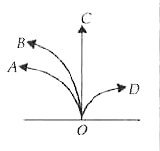A protn and an alpha particle enter into a uniform magnetic field with the same velocity. The period of rotation of the alpha particle will be
four times that of proton
two times that of proton
three times that of proton
same as that of proton
The correct Answer is:B
Step by step video, text & image solution for A protn and an alpha particle enter into a uniform magnetic field with the same velocity. The period of rotation of the alpha particle will be by Physics experts to help you in doubts & scoring excellent marks in Class 12 exams.
Topper's Solved these Questions
- BOOK - NARAYNACHAPTER - MOVING CHARGES AND MAGNETISMEXERCISE - LEVEL-I(C.W)58videos
MOVING CHARGES AND MAGNETISM
- BOOK - NARAYNACHAPTER - MOVING CHARGES AND MAGNETISMEXERCISE - Level-II(C.W)63videos
MOVING CHARGES AND MAGNETISM
- BOOK - NARAYNACHAPTER - MOVING CHARGES AND MAGNETISMEXERCISE - EXERCISE - 420videos
MOVING CHARGES AND MAGNETISM
- BOOK - NARAYNACHAPTER - MAGNETISM AND MATTEREXERCISE - EXERCISE - 4 (SINGLE ANSWER TYPE QUESTION)17videos
MAGNETISM AND MATTER
- BOOK - NARAYNACHAPTER - NUCLEAR PHYSICSEXERCISE - LEVEL-II-(H.W)9videos
NUCLEAR PHYSICS
Similar Questions
A proton and an α-particle enter in a uniform magnetic field perpendicularly with same speed. The ratio of time periods of both particle (TpTα) will be
View SolutionAssertion : If a proton and an α-particle enter a uniform magnetic field perpendicularly, with the same speed, then the time period of revolution of the -particle is double than that of proton.
Reason : In a magnetic field, the time period of revolution of a charged particle is directly proportional to mass.View Solution
Knowledge Check
- Question 1 - Select One
Assertion (A) : If a proton and an alpha particle enter a uniform magnetic field normally with the same velocity, the time period of revolution of the alpha particle is double than that of proton.
Reason (R) : In a magneitc field the time period of revolution of a charged particle is directly proportional to its mass.AIf both assertion and reason are true and the reason is the correct explanation of the assertion.BIf both assertion and reason are true but reason is not the correct explanation of the assertion.CIf assertion is true but reason is false .DIf the assertion is false but reason is true. - Question 2 - Select One
A proton and anα-particles enters in a uniform magnetic field with same velocity, then ratio of the radii of path describe by them
A0.042361111111111B0.043055555555556C0.084027777777778DNone of these - Question 3 - Select One
Statement 1: If a proton and an α-particle enter a uniform magnetic field perpendicularly with the same speed, the time period of revolution of α-particle is double than that of proton.
Statement 2: In a magnetic field, the period of revolution of a charged particle is directly proportional to the mass of the particle and inversely proprotional to the charge of particle.AIf both statement 1 and statement 2 are ture, statement 2 is the correct explanation of statement 1.BIf both statement 1 and statement 2 are ture, statement 2 is not the correct explanation of statement 1.CIf statement 1 is true, statement 2 is false.DIf statement 1 is false, statement 2 is true.
A neutron, a proton, an electron and an α- particle enter a region of uniform magnetic field with the same velocities. The magnetic field is perpendicular and directed into the plane of the paper. The tracks of the particles are labelled in the figure. The electron follows the track
 View Solution
View SolutionWhen a charged particle enters a uniform magnetic field its kinetic energy
View SolutionWhen a charged particle enters a uniform magnetic field its kinetic energy
View SolutionA proton and an a-particle enter in a uniform magnetic field perpendicularly with same speed. The will b ratio of time periods of both particle (TpTα will be
View SolutionA charged particle enters into a uniform magnetic field the parameter that remains constant is
View Solution

